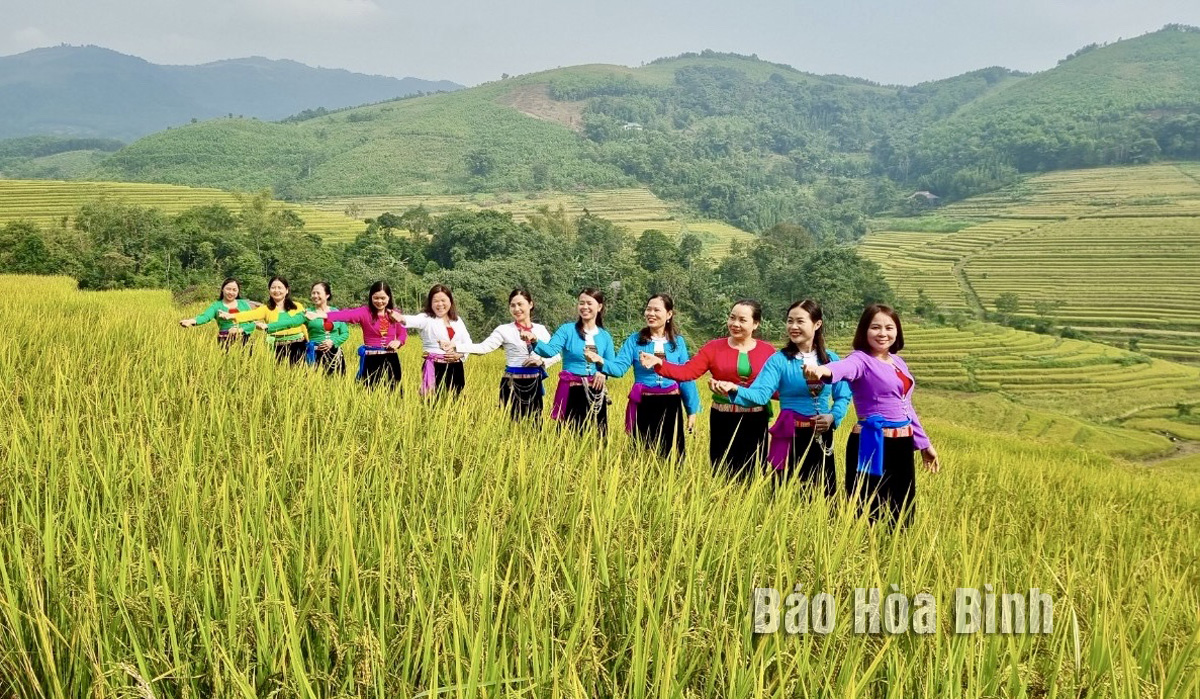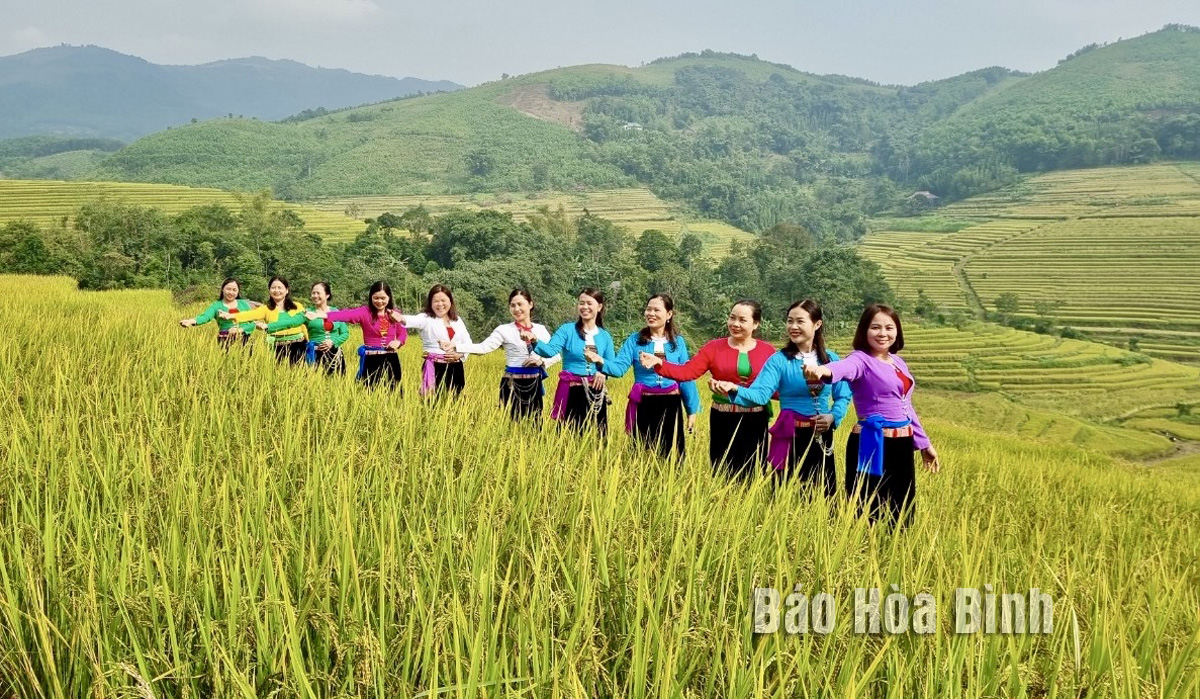
Spanning thousands of hectares and winding gracefully along mountain slopes, hillsides, and riverbanks, the terraced rice fields of Lac Son District present a stunning and captivating beauty. This region, renowned for its remarkable terraced landscapes, is also the centre of Hoa Binh Culture known for numerous archaeological sites.
Terraced fields in the ripen rice season in Mien Doi commune, Lac Son district, attract tourists to explore.
According to the "Terraced rice fields of the Muong people in Hoa Binh" heritage research project in 2021, the majority of the Muong's rice fields are located in Cao Phong, Tan Lac, and Lac Son districts. Among these, the terraced fields of Lac Son have been identified as the core area, featuring hundreds of plots of various sizes in an incredibly scenic landscape. Here, the practice of rice cultivation on terraced fields coexists with deeply rooted spiritual traditions passed down through generations, creating a rich material life and a sustainable ecosystem.
In comparison to other highland communes with preserved terraced fields, the mountainous area of Mien Doi boasts the most distinctive landscapes, covering approximately 800ha across several hamlets, including Thay Voi, Rom Bai, Renh, Than Tren, Than Duoi, Voi Thuong, and Voi Ha. Interspersed among these terraced fields are breathtaking waterfalls, which are some hundreds of meters high, along with small forests and traditional stilt houses, creating a harmonious scene where nature and humans coexist.
When talking about beautiful terraced fields, one cannot overlook those in the hamlets of Theu, Ve, Cu, Ngoc, Kem, Roi, and Doi Thung in Quy Hoa commune, which span around 300ha. These fields sit at elevations ranging from 300 to 750m, where the higher terrain features older natural forests, and the steeper fields blend seamlessly with the environment. In My Thanh commune, there are about 320 hectares divided into two main areas, namely the Co area and the hamlets of Pheo, Riec, Bo Ca, and Xi. Some plots run along the provincial road to Kim Boi, while others are nestled among villages, foothills and forested areas at elevations of 200 to 400m, creating a nice picture.
According to Nguyen The Hung, head of the Culture and Information Division of Lac Son district, the unique characteristics of the terraced field landscape in the Muong Vang region are the extensive and beautiful rice fields, interspersed with forests and the villages of the Muong people that have not been affected by urbanisation. The beauty of the terraced fields is complemented by the unspoiled nature surrounding them, featuring unique karst mountains, waterfalls, caves, grasslands, and hot springs. Additionally, the terraced fields are well-connected by inter-district transport routes, enhancing their accessibility for regional tourism.
The terraced rice fields are also an integral part of the cultural landscape, reflecting local customs, lifestyles, and the living spaces of the Muong community. The area is home to numerous archaeological sites that could serve as tourist attractions, such as the Trai hamlet cave in Tan Lap commune and rock carvings in the Grass hamlet of My Thanh commune. Currently, local authorities are actively promoting awareness among residents to protect and preserve these landscapes. They also focus on reviving and showcasing traditional festivals, particularly those related to rice cultivation, while promoting the tourism potential of these terraced fields. Attention is being paid to conservation and gradually develop tourism products.
With the terraced rice fields highlighting the stunning beauty of the mountainous region, Lac Son district is attracting tourists and various businesses interested in eco-tourism. Notably, the Sun Group has decided to invest in developing a high-end ecological resort at Doi Thung and Kha hot spring resort with a total investment of several trillion Vietnamese dong.
A diverse chain of eco-tourism and resort destinations concentrated in Hoa Binh city and the districts of Tan Lac, Da Bac, and Luong Son… Along with the launch of several key high-quality resort tourism projects, these developments have reshaped the landscape and enhanced the appeal of Hoa Binh as a travel destination.
Boasting diverse terrain, a mild climate, and rich natural resources, Cao Phong district is increasingly asserting its place on Vietnam’s tourism map, attracting both domestic and foreign visitors. The district is renowned for its stunning landscapes, majestic mountains, a crystal-clear hydropower lake, and the unique cultural identity of local ethnic groups.
With its pristine landscapes, unique cultural heritage of Muong ethnic minority, and an expanding range of visitor experiences, Tan Lac district of Hoa Binh has fast become a captivating destination for both domestic and international tourists.
Until now, Sung village in Cao Son commune, Da Bac district remains the only Dao ethnic community in Hoa Binh province to develop a community-based tourism model. Beyond its untouched natural landscapes, cultural identity serves as the cornerstone attraction for visitors.
Alongside the diverse cultural identities of the Kinh, Muong, Tay, Thai, Dao, and Mong ethnic people, Hoa Binh province is also renowned as the "capital" of the northwestern Vietnamese cuisine, offering unique and distinctive dishes. At festivals, during Lunar New Year (Tet), or on significant family or community occasions, special dishes are prepared, leaving a lasting impression on visitors.
A Phong Linh (Yellow Tabebuia) flower garden in Thang village, Thach Yen commune, Cao Phong district is currently in full bloom, drawing a large number of visitors.



